A Novel Approach to Evaluating Industrial Spatial Structure Upgrading: Evidence from 284 Cities and 96 Sub-Industries in China (1978–2022)
Abstract
:1. Introduction
2. Literature Review
3. The Core Foundations of the New Approaches
3.1. Overview of Evaluation Methods for Industrial Structure Upgrading
3.1.1. Traditional Proportional Method
3.1.2. Industrial Structure Hierarchy Coefficient
3.1.3. The Production Efficiency Method
3.1.4. The Cosine Angle Method
3.2. Advancing Evaluation Approaches for Industrial Spatial Structure Upgrading: Core Foundations
3.3. Sensitivity Analysis of the New Approach: Algorithmic Simulation Through Sampling
3.3.1. Sensitivity Analysis Under Different Spatial Weight Matrix Settings
3.3.2. Sensitivity Analysis with Varying Numbers of Regions, Periods, and Industrial Categories
4. Application of the New Method: An Evaluation Using Firm Survival Big Data from 284 Chinese Cities Across 96 Industry Categories (1978–2022)
4.1. Defining Evaluation Details
- (1)
- Definition of the 284 cities: This study focuses on cities at or above the prefecture level within the 31 provinces, autonomous regions, and municipalities of mainland China, as listed in Table 1. It is worth noting that, according to the China Statistical Yearbook (2024) [31], there are a total of 297 cities at or above the prefecture level in Mainland China, including the four municipalities directly under the central government: Beijing, Tianjin, Shanghai, and Chongqing. For the sake of data completeness, this study selects 284 prefecture-level cities, as shown in Table 1, while the remaining 13 cities are excluded from the analysis framework due to issues such as administrative restructuring or incomplete data during the analysis period.
- (2)
- Definition of the time period: The study selects 1978 as the starting year, given its significance as the beginning of China’s reform and opening-up, a milestone in the country’s industrial transformation. As data beyond 2023 in all the cities have not yet been updated, the study period extends until 2022.
- (3)
- (4)
- Determination of industrial proportions: The study quantifies each city’s industrial proportion based on the share of surviving firms in a given industry relative to the total number of firms in that city for a specific period. To achieve this, Python 3.12 was used to collect firm registration data from the “Tianyancha” website, covering all registered firms in China, with data collection conducted from July to September 2024. The survival status of firms was determined based on their registration and operational years, allowing attribution to specific years and cities. Using each firm’s industry classification, the number of surviving firms across 96 sub-industries in 284 cities from 1978 to 2022 was determined. Finally, the industrial proportion for each city in a given year was calculated as the ratio of surviving firms in a specific industry to the total surviving firms across all industries in that city.
- (5)
- Construction of spatial weight matrices: To analyze spatial spillover effects among the 284 cities, this study constructs three types of spatial weight matrices. W1 is based on the inverse square of commuting distance between cities, W2 on the inverse square of geodetic distance, and W3 on the inverse square of commuting time. Commuting distances and times between cities are derived from municipal government locations, obtained using Python and the Gaode Map API. Geodetic (latitude–longitude) distances between cities are calculated using ArcGIS 10.8The three types of spatial weight matrices are illustrated in Figure 6.
4.2. Evaluation Results of Industrial Spatial Structure Upgrading Levels and Their Dynamic Evolution for 284 Cities in China (1978–2022)
4.3. Further Evaluation: Levels of Industrial Spatial Structure Upgrading and Their Dynamic Evolution for 284 Cities in China from the Perspective of the Primary, Secondary, and Tertiary Industries (1978–2022)
5. Conclusions and Remarks
Author Contributions
Funding
Data Availability Statement
Conflicts of Interest
References
- Fu, L. An Empirical Research on Industry Structure and Economic Growth. Stat. Res. 2010, 27, 79–81. [Google Scholar]
- Yang, L.; Shao, J. Re-estimation of optimization of regional industrial structure in China. J. Quant. Technol. Econ. 2018, 35, 59–77. [Google Scholar]
- Fujita, M.; Krugman, P.; Venables, A.J. The Spatial Economy: Cities, Regions, and International Trade; The MIT Press: Cambridge, MA, USA, 1999. [Google Scholar]
- Krugman, P.P.; Obstfeld, M. International Economics: Theory and Policy; Pearson-Addison: New York, NY, USA, 2002. [Google Scholar]
- Christaller, W. Central Places in Southern Germany; Prentice-Hall: Englewood Cliffs, NJ, USA, 1933. [Google Scholar]
- Perroux, F. Economic Space: Theory and Applications. Q. J. Econ. 1950, 64, 89–104. [Google Scholar] [CrossRef]
- Tian, X.; Gao, W.; Liu, Y.; Xu, M. Secondary resource curse’s formation and transmission mechanism based on environmental externality theory. Resour. Conserv. Recycl. 2020, 161, 104958. [Google Scholar] [CrossRef]
- Shi, K.; Wang, J. The influence and spatial effects of high-speed railway construction on urban industrial upgrading: Based on an industrial transfer perspective. Socio-Econ. Plan. Sci. 2024, 93, 101886. [Google Scholar] [CrossRef]
- Feng, T.; Liu, B.; Wei, Y.; Xu, Y.; Zheng, H.; Ni, Z.; Zhu, Y.; Fan, X.; Zhou, Z. Research on the low-carbon path of regional industrial structure optimization. Energy Strategy Rev. 2024, 54, 101485. [Google Scholar] [CrossRef]
- Zhang, Q.; Zhao, X. Can the digital economy facilitate the optimization of industrial structure in resource-based cities? Struct. Change Econ. Dyn. 2024, 71, 405–416. [Google Scholar] [CrossRef]
- Zhou, X.; Ji, J. A multi-objective optimization approach for interprovincial carbon emission reduction in China: Considering industrial structure and ownership attributes. J. Environ. Manag. 2025, 373, 123646. [Google Scholar] [CrossRef]
- Fan, P.; Yue, W.; Zhang, J.; Huang, H.; Messina, J.; Verburg, P.H.; Qi, J.; Moore, N.; Ge, J. The spatial restructuring and determinants of industrial landscape in a mega city under rapid urbanization. Habitat Int. 2020, 95, 102099. [Google Scholar] [CrossRef]
- Chen, Z.; Zhang, S. The spatial correlation between green investment and energy-structure optimization: Evidence from China. Energy Strategy Rev. 2024, 53, 101391. [Google Scholar] [CrossRef]
- Meijers, E.J.; Burger, M.J. Spatial structure and productivity in US metropolitan areas. Environ. Plan. A 2010, 42, 1383–1402. [Google Scholar] [CrossRef]
- Chen, H.; Yu, J.; Ma, S.; Zhang, W. Urban scale, production efficiency, and dynamic development paths. Cities 2023, 143, 104566. [Google Scholar] [CrossRef]
- Xu, L.; Tan, J. Financial development, industrial structure and natural resource utilization efficiency in China. Resour. Policy 2020, 66, 101642. [Google Scholar] [CrossRef]
- Lin, B.; Teng, Y. The effect of industrial synergy and division on energy intensity: From the perspective of industrial chain. Energy 2023, 283, 128487. [Google Scholar] [CrossRef]
- Fan, C.C.; Scott, A.J. Industrial agglomeration and development: A survey of spatial economic issues in East Asia and a statistical analysis of Chinese regions. Econ. Geogr. 2003, 79, 295–319. [Google Scholar] [CrossRef]
- Zhang, L.; He, X.; Jia, Z. Industrial agglomeration, public services and city size: Evidence from 286 cities in China. Land Use Policy 2023, 131, 106758. [Google Scholar] [CrossRef]
- Hao, X.; Li, Y.; Ren, S.; Wu, H.; Hao, Y. The role of digitalization on green economic growth: Does industrial structure optimization and green innovation matter? J. Environ. Manag. 2023, 325, 116504. [Google Scholar] [CrossRef]
- Cheng, Z.; Li, L.; Liu, J. Industrial structure, technical progress, and carbon intensity in China’s provinces. Renew. Sustain. Energy. Rev. 2018, 81, 2935–2946. [Google Scholar] [CrossRef]
- Cheng, Y.; Geng, X.; Tian, W. Achieving low-carbon production: Impacts of land misallocation and industrial structure in urban China. Appl. Energy 2025, 378, 124791. [Google Scholar] [CrossRef]
- Shen, H.; Qin, M.; Li, T.; Zhang, X.; Zhao, Y. Digital finance and industrial structure upgrading: Evidence from Chinese counties. Int. Rev. Financ. Anal. 2024, 95, 103442. [Google Scholar] [CrossRef]
- Gan, C.; Zheng, R.; Yu, D. An empirical study on the effects of industrial structure on economic growth and fluctuations in China. Econ. Res. J. 2011, 46, 4–16&31. [Google Scholar]
- Jiang, M.; Luo, S.; Zhou, G. Financial development, OFDI spillovers and upgrading of industrial structure. Technol. Forecast. Soc. Chang. 2020, 155, 119974. [Google Scholar] [CrossRef]
- Yuan, H.; Zhu, C. Do national high-tech zones promote the transformation and upgrading of China’s industrial structure. China Ind. Econ. 2018, 8, 60–77. [Google Scholar] [CrossRef]
- Ren, X.; Zeng, G.; Gozgor, G. How does digital finance affect industrial structure upgrading? Evidence from Chinese prefecture-level cities. J. Environ. Manag. 2023, 330, 117125. [Google Scholar] [CrossRef] [PubMed]
- Liu, W.; Zhang, H.; Huang, Z. A study of industry structure degree, industrialization process and regional difference in China. Econ. Perspect. 2008, 11, 4–8. [Google Scholar]
- Chang, H.; Ding, Q.; Zhao, W.; Hou, N.; Liu, W. The digital economy, industrial structure upgrading, and carbon emission intensity—empirical evidence from China’s provinces. Energy Strategy Rev. 2023, 50, 101218. [Google Scholar] [CrossRef]
- Wu, N.; Liu, Z. Higher education development, technological innovation and industrial structure upgrade. Technol. Forecast. Soc. Change 2021, 162, 120400. [Google Scholar] [CrossRef]
- National Bureau of Statistics of China. China Statistical Yearbook (2024); China Statistics Press: Beijing, China, 2024. [Google Scholar]
- GB/T 4754—2017; Industrial Classification for National Economic Activities (UNSD: 2006, International Standard Industrial Classification of All Economic Activities, NEQ). National Standards of the People’s Republic of China: Beijing, China, 2017.
- Xiang, X.; Fan, Q. Advancing Green TFP Calculation: A Novel Spatiotemporal Econometric Solow Residual Method and Its Application to China’s Urban Industrial Sectors. Mathematics 2024, 12, 1365. [Google Scholar] [CrossRef]
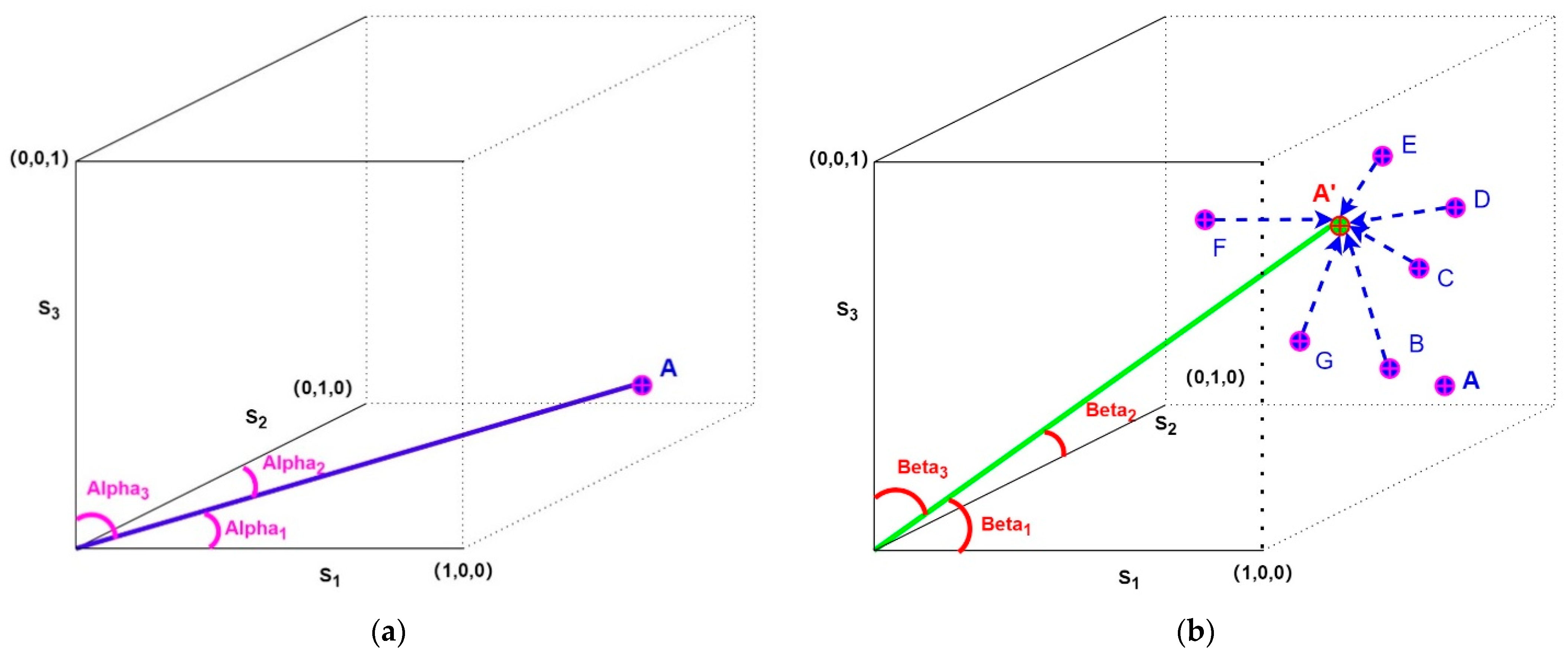
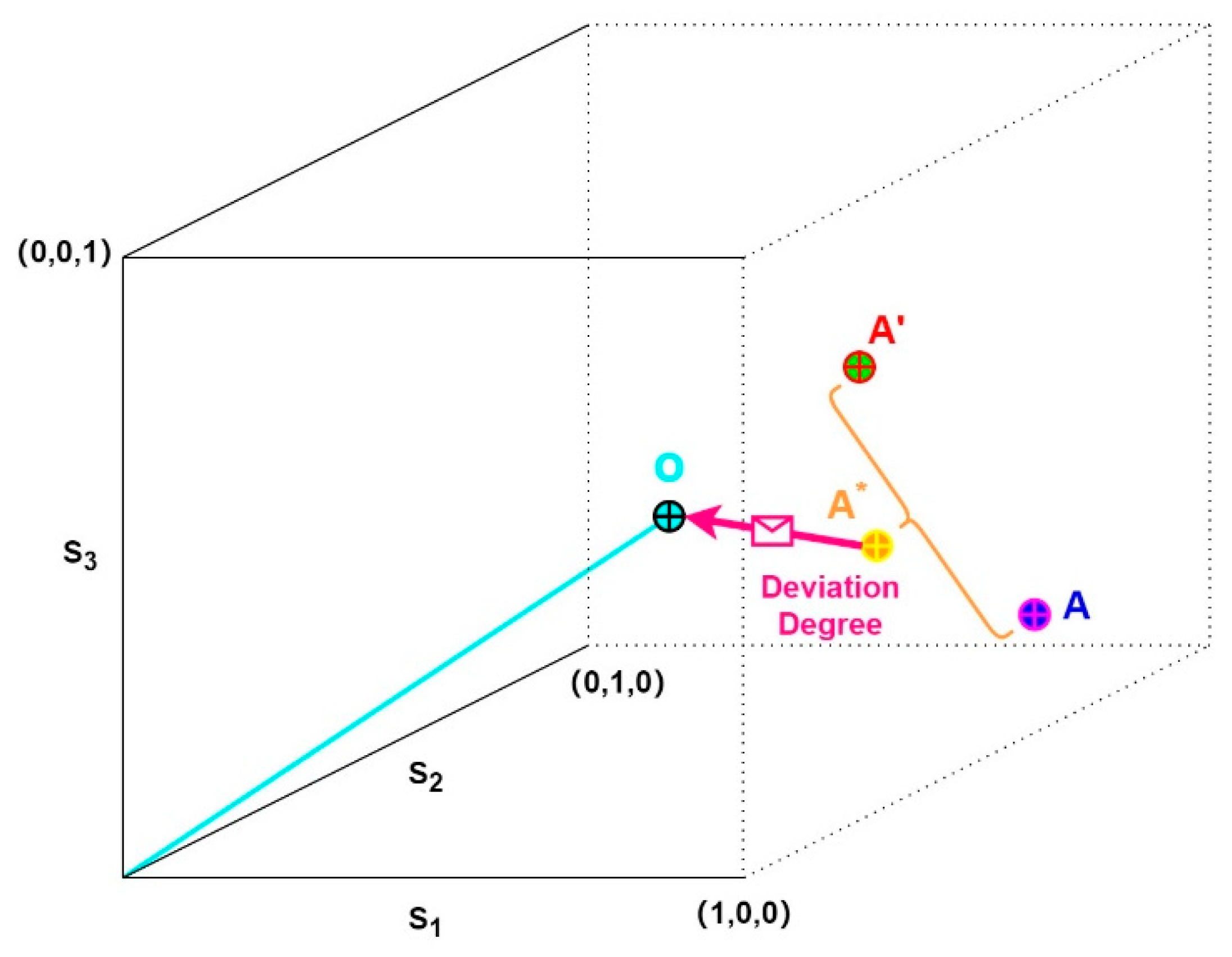

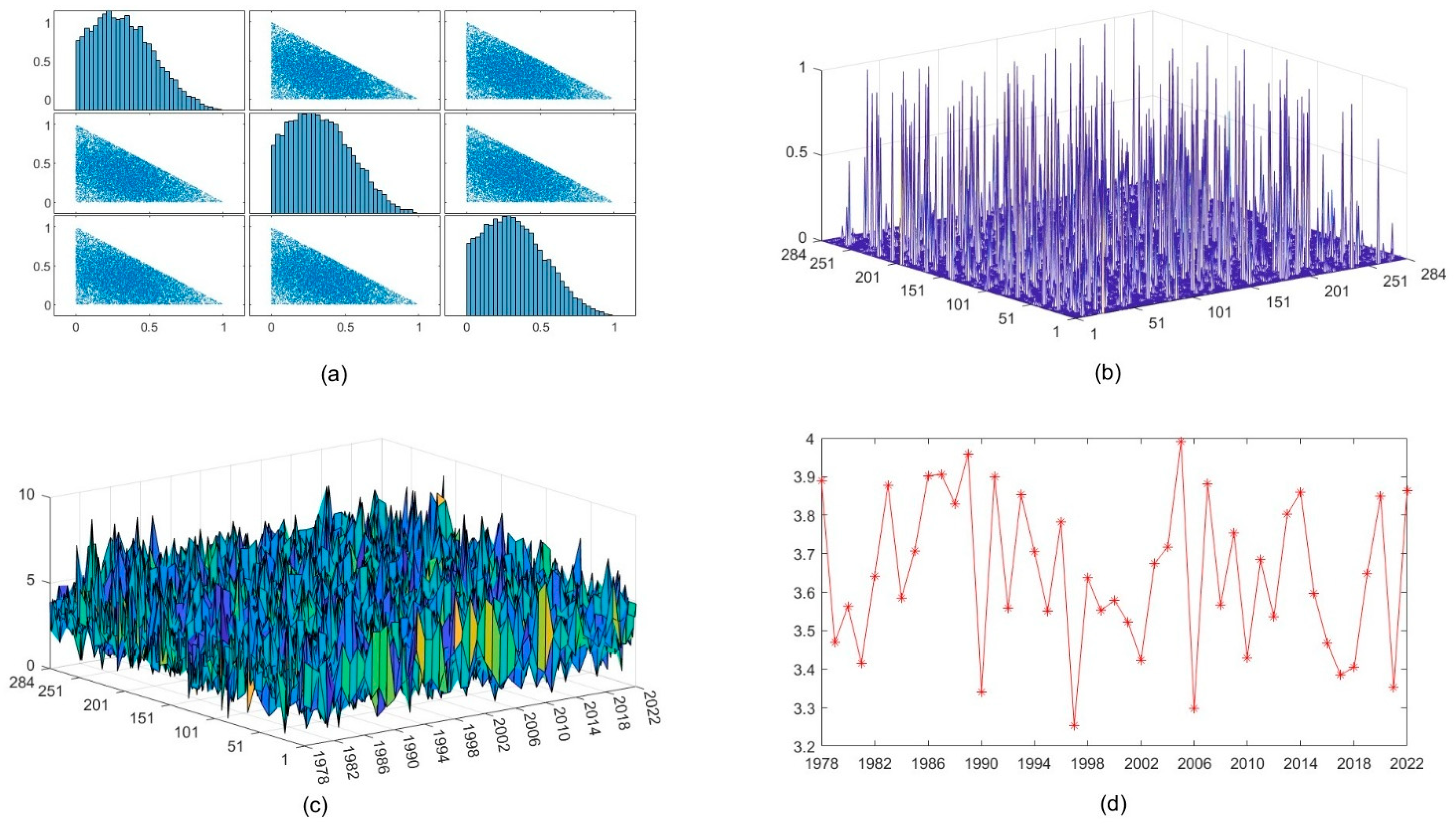
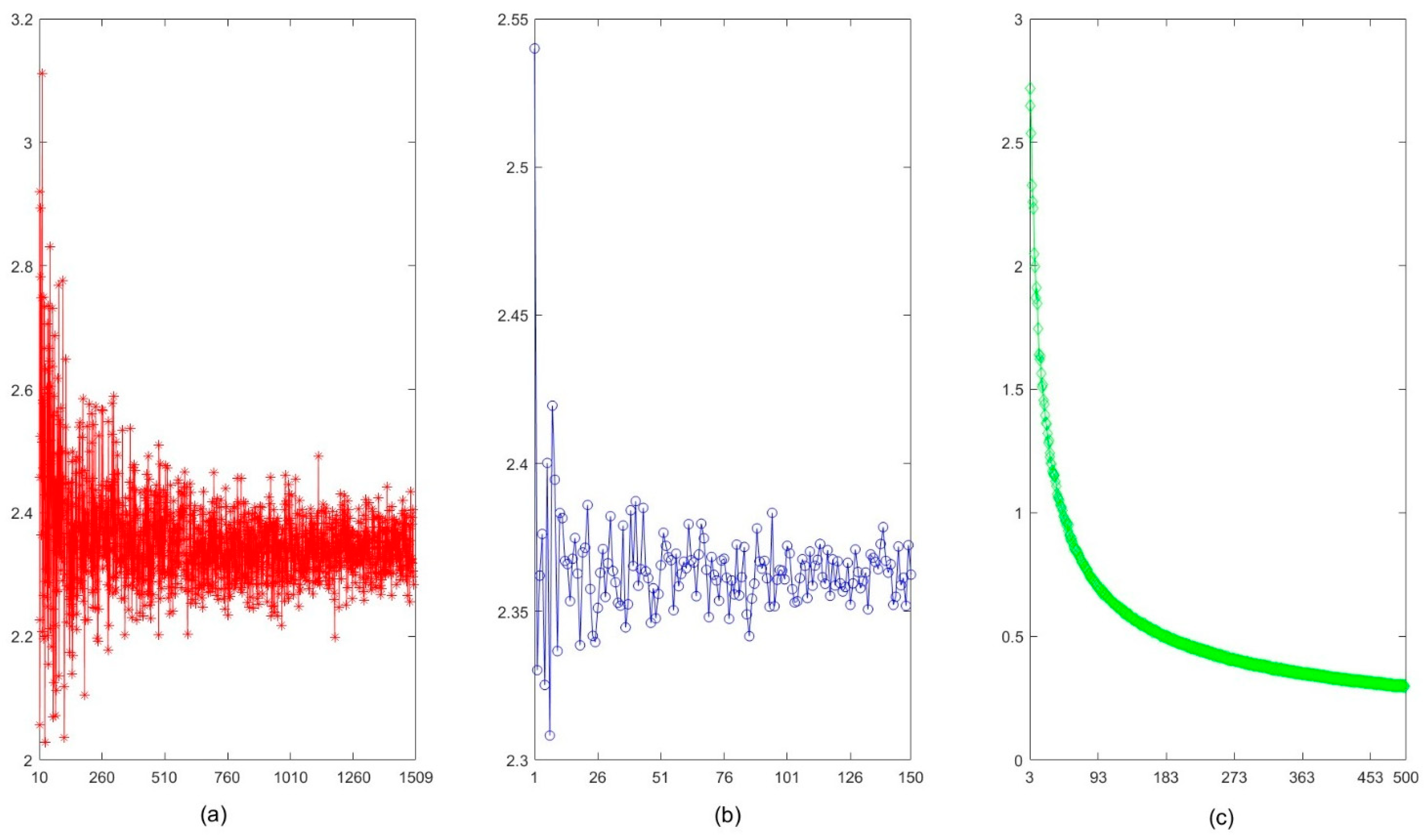

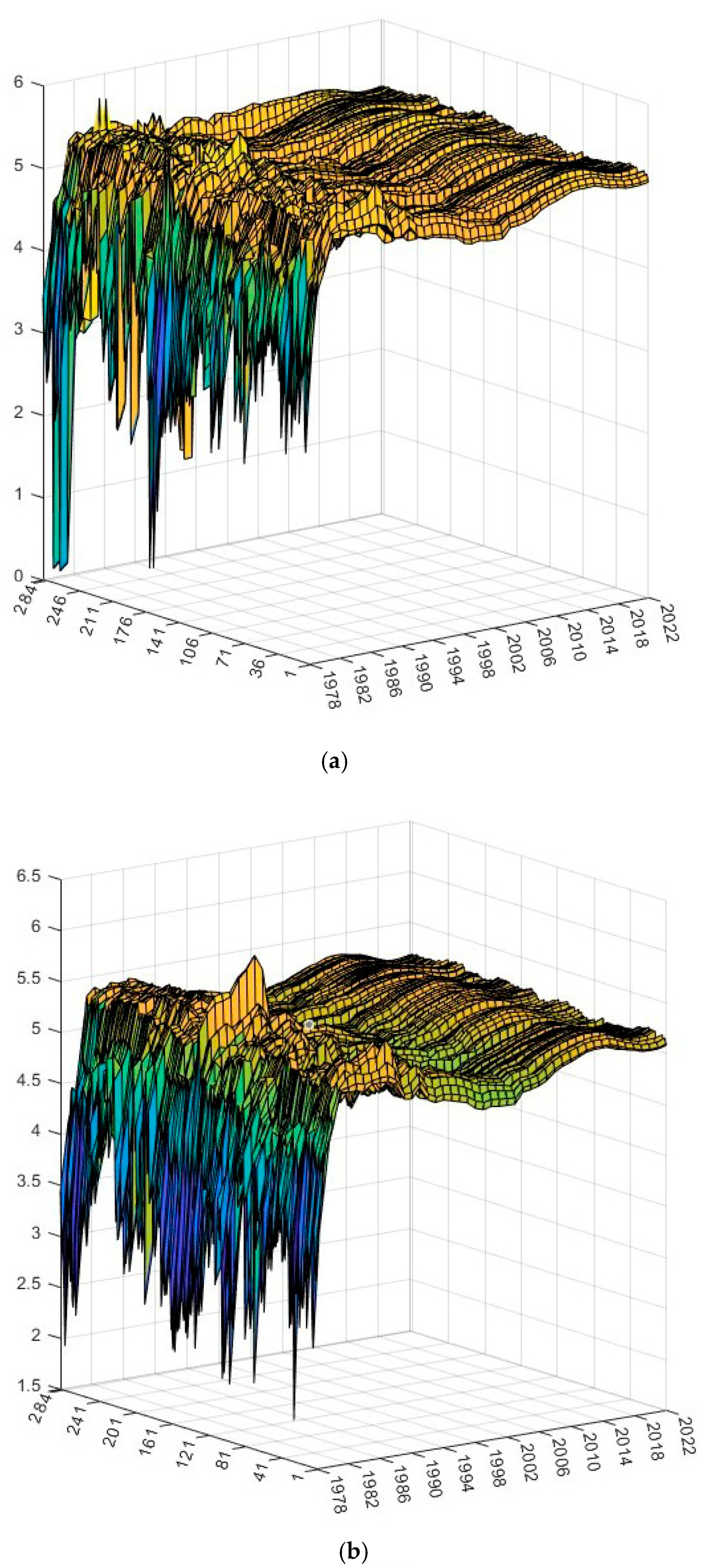
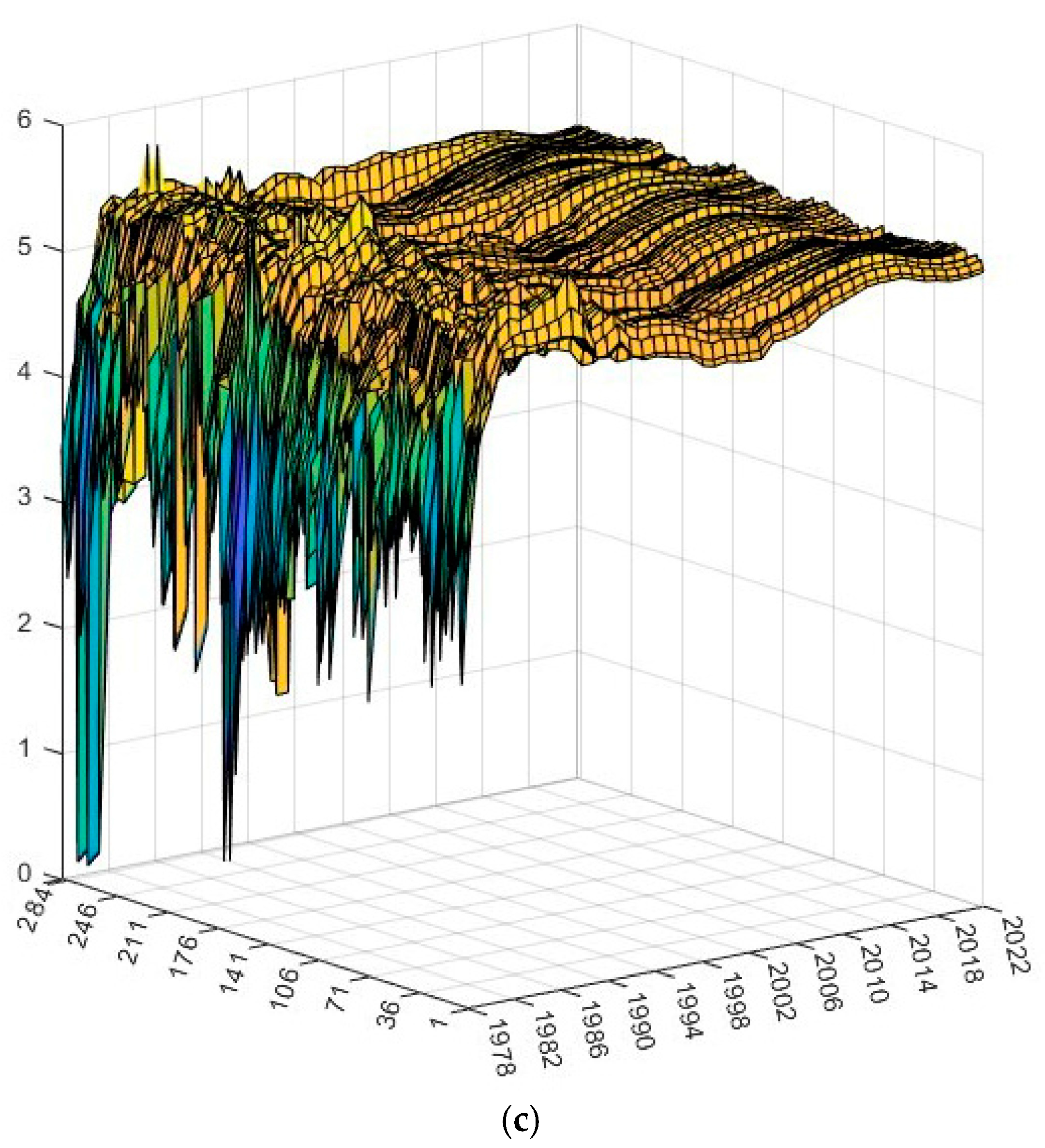


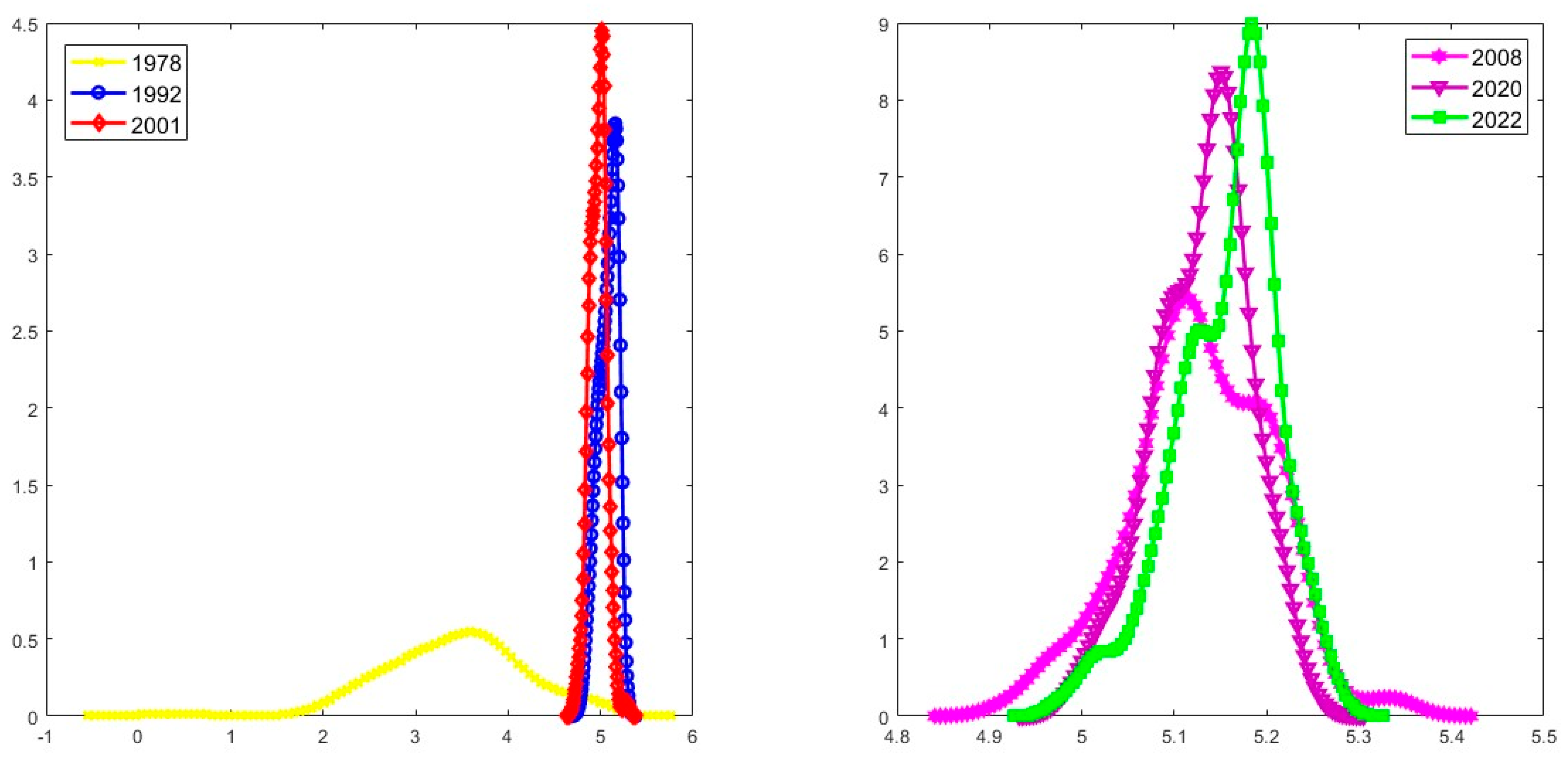
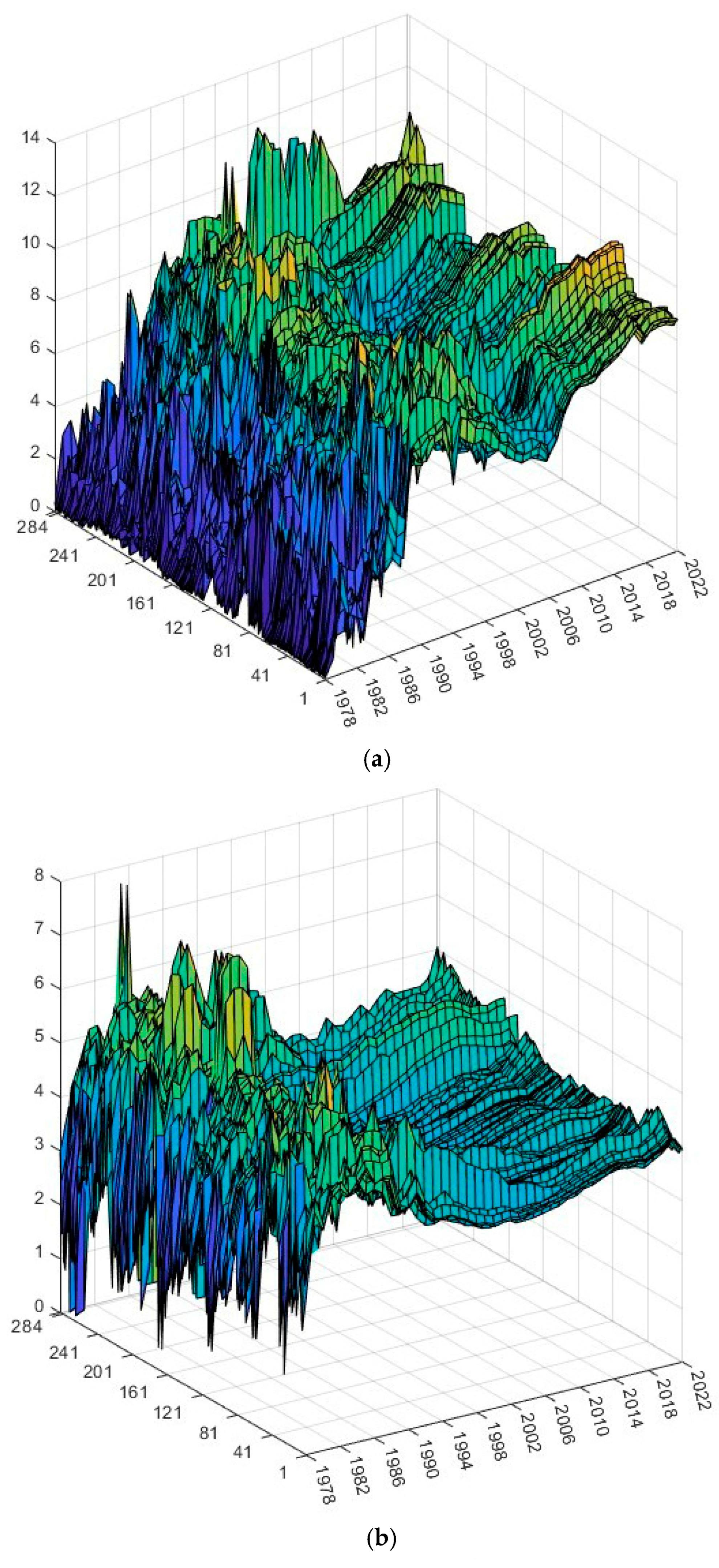
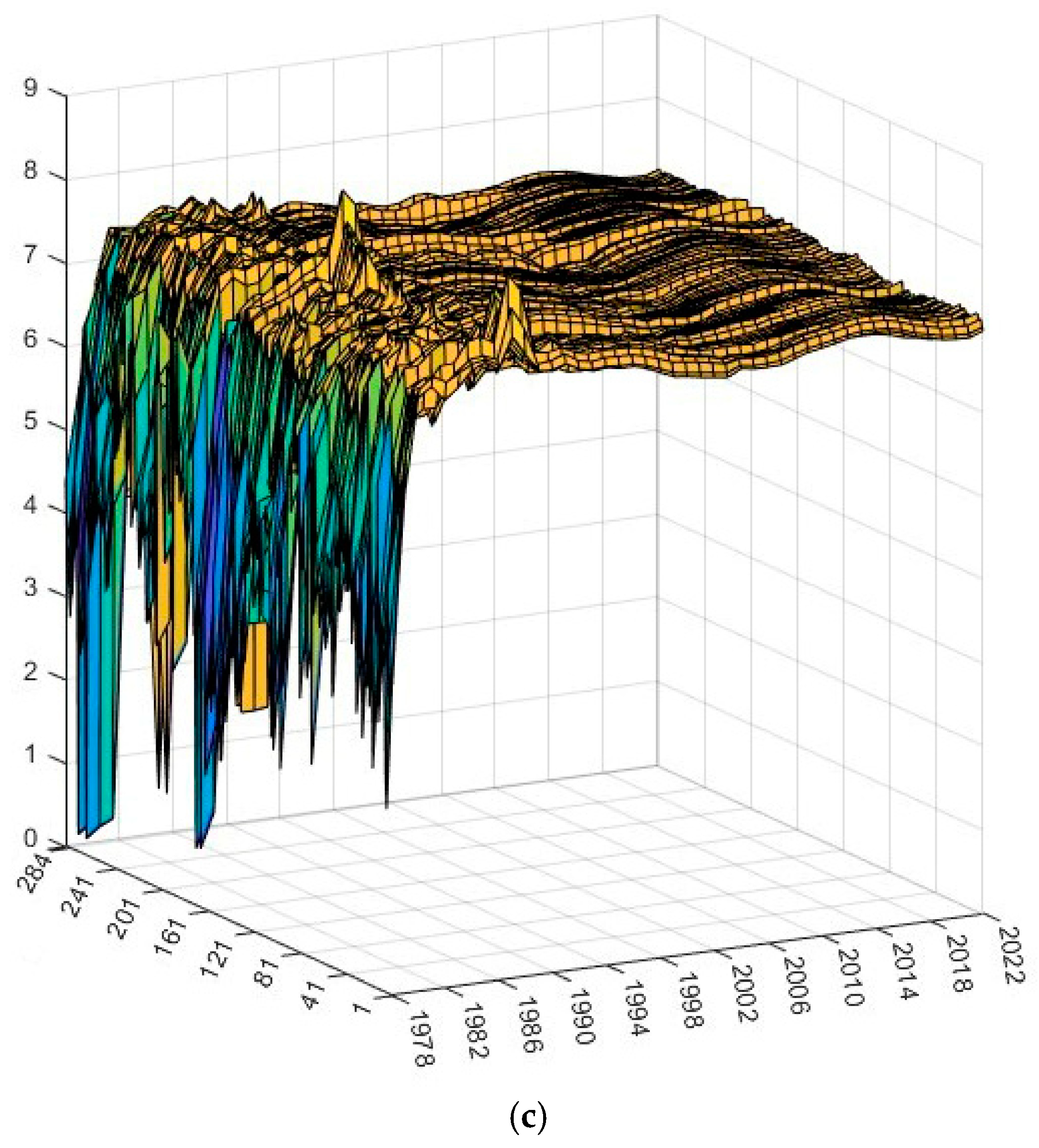

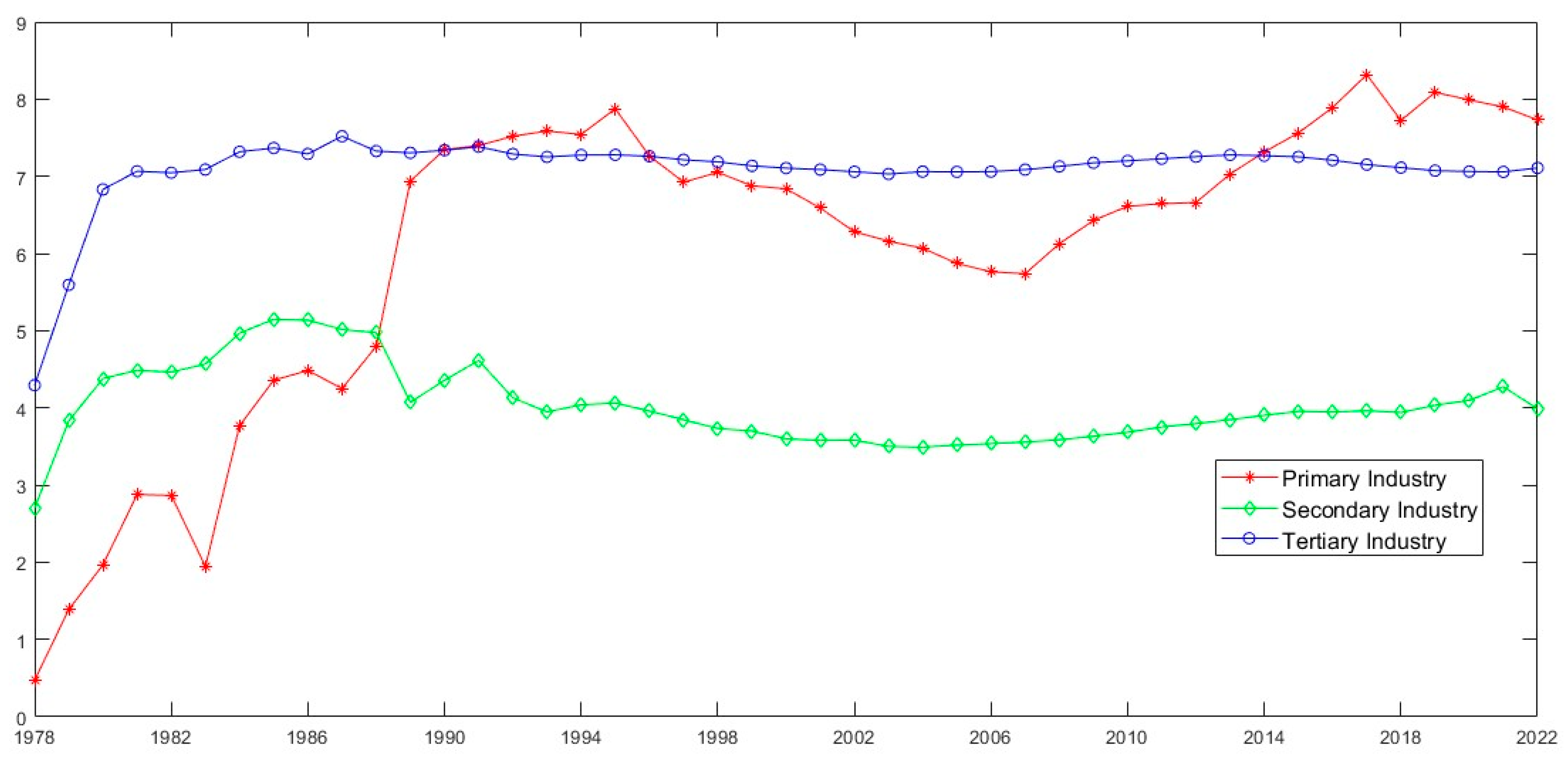

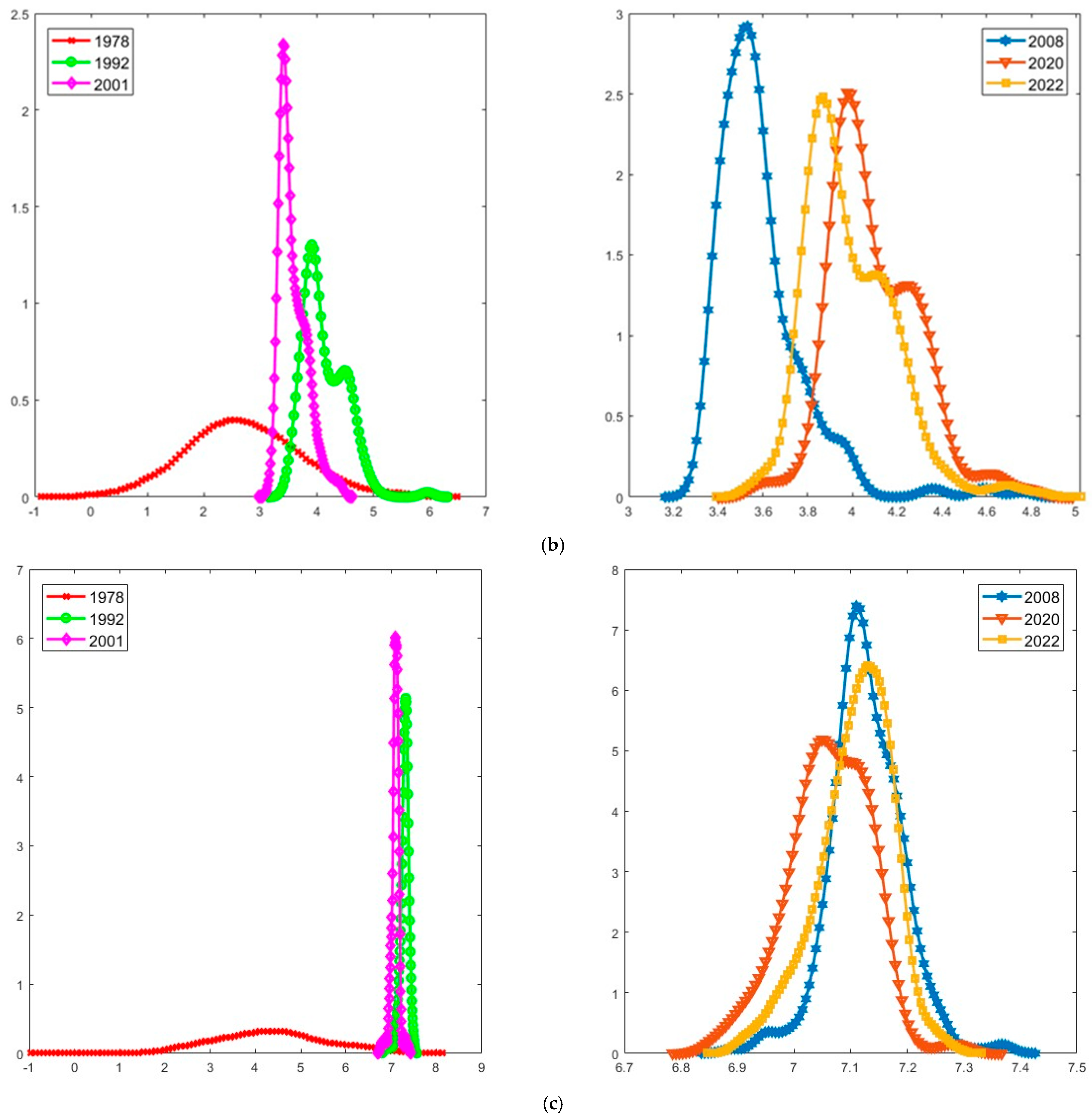
| Provinces, Autonomous Regions, or Municipalities | Cities | Total Number of Cities | City Code |
|---|---|---|---|
| Beijing | Beijing | 1 | 1 |
| Tianjin | Tianjin | 1 | 2 |
| Hebei | Shijiazhuang, Tangshan, Qinhuangdao, Handan, Xingtai, Baoding, Zhangjiakou, Chengde, Cangzhou, Langfang, Hengshui | 11 | 3~13 |
| Shanxi | Taiyuan, Datong, Yangquan, Changzhi, Jincheng, Shuozhou, Jinzhong, Yuncheng, Xinzhou, Linfen, Lüliang | 11 | 14~24 |
| Inner Mongolia | Hohhot, Baotou, Wuhai, Chifeng, Tongliao, Ordos, Hulunbuir, Bayannur, Ulanqab | 9 | 25~33 |
| Liaoning | Shenyang, Dalian, Anshan, Fushun, Benxi, Dandong, Jinzhou, Yingkou, Fuxin, Liaoyang, Panjin, Tieling, Chaoyang, Huludao | 14 | 34~47 |
| Jilin | Changchun, Jilin, Siping, Liaoyuan, Tonghua, Baishan, Songyuan, Baicheng | 8 | 48~55 |
| Heilongjiang | Harbin, Qiqihar, Jixi, Hegang, Shuangyashan, Daqing, Yichun, Jiamusi, Qitaihe, Mudanjiang, Heihe, Suizhong | 12 | 56~67 |
| Shanghai | Shanghai | 1 | 68 |
| Jiangsu | Nanjing, Wuxi, Xuzhou, Changzhou, Suzhou, Nantong, Lianyungang, Huai’an, Yancheng, Yangzhou, Zhenjiang, Taizhou, Suqian | 13 | 69~81 |
| Zhejiang | Hangzhou, Ningbo, Wenzhou, Jiaxing, Huzhou, Shaoxing, Jinhua, Quzhou, Zhoushan, Taizhou, Lishui | 13 | 82~94 |
| Anhui | Hefei, Wuhu, Bengbu, Huainan, Ma’anshan, Huabei, Tongling, Anqing, Huangshan, Chuzhou, Fuyang, Suzhou, Liuzhou | 13 | 95~107 |
| Fujian | Fuzhou, Xiamen, Putian, Sanming, Quanzhou, Zhangzhou, Nanping, Longyan, Ningde | 9 | 108~116 |
| Jiangxi | Nanchang, Jingdezhen, Pingxiang, Ji’an, Yichun, Fuzhou, Shangrao, Xinyu, Yingtan, Ganzhou, Ji’an | 11 | 117~127 |
| Shandong | Jinan, Qingdao, Zibo, Zaozhuang, Dongying, Yantai, Weifang, Jining, Tai’an, Weihai, Rizhao, Linyi, Dezhou, Liaocheng, Binzhou, Heze | 16 | 128~143 |
| Henan | Zhengzhou, Kaifeng, Luoyang, Pingdingshan, Anyang, Hebi, Xinxiang, Jiaozuo, Puyang, Xuchang, Luohe, Sanmenxia, Nanyang, Shangqiu, Xinyang, Zhoukou, Zhumadian | 17 | 144~160 |
| Hubei | Wuhan, Huangshi, Shiyan, Yichang, Xiangyang, Ezhou, Jingmen, Xiaogan, Jingzhou, Huanggang, Xianning, Suizhou | 13 | 161~173 |
| Hunan | Changsha, Zhuzhou, Xiangtan, Hengyang, Shaoyang, Yueyang, Changde, Zhangjiajie, Yiyang, Chenzhou, Yongzhou, Huaihua, Loudi | 13 | 174~186 |
| Guangdong | Guangzhou, Shaoguan, Shenzhen, Zhuhai, Shantou, Foshan, Jiangmen, Zhanjiang, Maoming, Zhaoqing, Huizhou, Meizhou, Shanwei, Heyuan, Yangjiang, Qingyuan, Dongguan, Zhongshan, Chaozhou, Jieyang, Yunfu | 21 | 187~207 |
| Guangxi | Nanning, Liuzhou, Guilin, Wuzhou, Beihai, Fangchenggang, Qinzhou, Guigang, Yulin, Baise, Hezhou, Hechi, Laibin, Chongzuo | 14 | 208~221 |
| Hainan | Haikou, Sanya | 2 | 222~223 |
| Chongqing | Chongqing | 1 | 224 |
| Sichuan | Chengdu, Zigong, Panzhihua, Luzhou, Deyang, Mianyang, Guangyuan, Suining, Neijiang, Leshan, Nanchong, Meishan, Yibin, Guang’an, Dazhou, Ya’an, Bazhong, Ziyang | 18 | 225~242 |
| Guizhou | Guiyang, Liupanshui, Zunyi, Anshun | 4 | 243~246 |
| Yunnan | Kunming, Qujing, Yuxi, Baoshan, Zhaotong, Lijiang, Lincang | 7 | 247~253 |
| Xizang | Lhasa | 1 | 254 |
| Shaanxi | Xi’an, Tongchuan, Baoji, Xianyang, Weinan, Yan’an, Hanzhong, Yulin, Ankang, Shangluo | 10 | 255~264 |
| Gansu | Lanzhou, Jiayuguan, Jinchang, Baiyin, Tianshui, Wuwei, Zhangye, Pingliang, Jiuquan, Qingyang, Dingxi, Longnan | 12 | 265~276 |
| Qinghai | Xining | 1 | 277 |
| Ningxia | Yinchuan, Shizuishan, Wuzhong, Guyuan, Zhongwei | 5 | 278~282 |
| Xinjiang | Urumqi, Karamay | 2 | 283~284 |
| Number | Industry Categories | Major Categories | Number | Industry Categories | Major Categories | Number | Industry Categories | Major Categories |
|---|---|---|---|---|---|---|---|---|
| 1 | Insurance Industry | III | 33 | Education | III | 65 | Water Production and Supply Industry | II |
| 2 | Catering Industry | III | 34 | Repair of Metal Products, Machinery, and Equipment | II | 66 | Water Conservancy Management Industry | III |
| 3 | Animal Husbandry | I | 35 | Metal Products Industry | II | 67 | Water Transport Industry | III |
| 4 | Road Transport Industry | III | 36 | Alcoholic Beverages, Soft Drinks, and Refined Tea Manufacturing | II | 68 | Sports | III |
| 5 | Electric Power, Steam Production and Supply Industry | II | 37 | Residential Services Industry | III | 69 | Railway, Shipbuilding, Aerospace and Other Transport Equipment Manufacturing | II |
| 6 | Electrical Machinery and Equipment Manufacturing | II | 38 | Mining Support Activities | II | 70 | Railway Transport Industry | III |
| 7 | Telecommunications, Broadcasting, Television, and Satellite Transmission Services | III | 39 | Science and Technology Promotion and Application Services | III | 71 | General Equipment Manufacturing Industry | II |
| 8 | Multimodal Transport and Freight Forwarding Industry | III | 40 | Forestry | I | 72 | Land Management Industry | III |
| 9 | Real Estate Industry | III | 41 | Retail Industry | III | 73 | Civil Engineering Construction Industry | II |
| 10 | Residential Building Industry | II | 42 | Coal Mining and Dressing Industry | II | 74 | Health | III |
| 11 | Textile, Apparel and Accessories Industry | II | 43 | Wood Processing and Wood, Bamboo, Rattan, Palm and Grass Products Manufacturing | II | 75 | Culture and Arts Industry | III |
| 12 | Textile Industry | II | 44 | Agriculture, Forestry, Animal Husbandry, Fishery and Related Activities | I | 76 | Cultural, Educational, Craft, Sports and Entertainment Goods Manufacturing | II |
| 13 | Non-Metallic Mineral Mining and Selection Industry | II | 45 | Agricultural and Sideline Food Processing Industry | II | 77 | Rubber and Plastic Products Industry | II |
| 14 | Non-Metallic Mineral Products Industry | II | 46 | Agriculture | I | 78 | News and Publishing Industry | III |
| 15 | Waste Resource Recycling Industry | II | 47 | Wholesale Industry | III | 79 | Tobacco Products Industry | II |
| 16 | Public Facility Management Industry | III | 48 | Leather, Fur, Feathers and Their Products and Footwear Manufacturing | II | 80 | Research and Experimental Development | III |
| 17 | Pipeline Transport Industry | III | 49 | Other Mining Industry | II | 81 | Pharmaceutical Manufacturing Industry | II |
| 18 | Broadcasting, Television, Film and Recording Production Industry | III | 50 | Other Services Industry | III | 82 | Instrument and Meter Manufacturing Industry | II |
| 19 | Government Institutions | III | 51 | Other Financial Industry | III | 83 | Printing and Reproduction of Recorded Media Industry | II |
| 20 | Air Transport Industry | III | 52 | Other Manufacturing Industry | II | 84 | Postal Industry | III |
| 21 | Ferrous Metal Mining and Selection Industry | II | 53 | Automobile Manufacturing Industry | II | 85 | Non-Ferrous Metal Mining and Selection Industry | II |
| 22 | Ferrous Metal Smelting and Rolling Industry | II | 54 | Mass Organizations, Social Groups, and Other Membership Organizations | III | 86 | Non-Ferrous Metal Smelting and Rolling Industry | II |
| 23 | Internet and Related Services | III | 55 | Gas Production and Supply Industry | II | 87 | Entertainment Industry | III |
| 24 | Chemical Fiber Manufacturing | II | 56 | Chinese People’s Political Consultative Conference, Democratic Parties | III | 88 | Fishery | I |
| 25 | Chemical Raw Materials and Chemical Products Manufacturing | II | 57 | Software and Information Technology Services Industry | III | 89 | Pulp, Paper and Paper Products Industry | II |
| 26 | Monetary and Financial Services | III | 58 | Commercial Services Industry | III | 90 | Communist Party of China Institutions | III |
| 27 | Repair of Motor Vehicles, Electronics, and Household Products | III | 59 | Social Security | III | 91 | Accommodation Industry | III |
| 28 | Grassroots Mass Autonomous Organizations and Other Organizations | III | 60 | Social Work | III | 92 | Professional Technical Services Industry | III |
| 29 | Computer, Communications and Other Electronic Equipment Manufacturing | II | 61 | Ecological Protection and Environmental Management Industry | III | 93 | Professional Equipment Manufacturing Industry | II |
| 30 | Furniture Manufacturing Industry | II | 62 | Petroleum, Coal, and Other Fuel Processing Industry | II | 94 | Loading, Unloading and Storage Industry | III |
| 31 | Construction and Installation Industry | II | 63 | Petroleum and Natural Gas Mining Industry | II | 95 | Capital Market Services | III |
| 32 | Building Decoration, Renovation and Other Construction Industries | II | 64 | Food Manufacturing Industry | II | 96 | Leasing Industry | III |
Disclaimer/Publisher’s Note: The statements, opinions and data contained in all publications are solely those of the individual author(s) and contributor(s) and not of MDPI and/or the editor(s). MDPI and/or the editor(s) disclaim responsibility for any injury to people or property resulting from any ideas, methods, instructions or products referred to in the content. |
© 2025 by the authors. Licensee MDPI, Basel, Switzerland. This article is an open access article distributed under the terms and conditions of the Creative Commons Attribution (CC BY) license (https://creativecommons.org/licenses/by/4.0/).
Share and Cite
Fan, Q.; Liang, N.; Zhang, Z. A Novel Approach to Evaluating Industrial Spatial Structure Upgrading: Evidence from 284 Cities and 96 Sub-Industries in China (1978–2022). Mathematics 2025, 13, 1279. https://doi.org/10.3390/math13081279
Fan Q, Liang N, Zhang Z. A Novel Approach to Evaluating Industrial Spatial Structure Upgrading: Evidence from 284 Cities and 96 Sub-Industries in China (1978–2022). Mathematics. 2025; 13(8):1279. https://doi.org/10.3390/math13081279
Chicago/Turabian StyleFan, Qiao, Na Liang, and Zihan Zhang. 2025. "A Novel Approach to Evaluating Industrial Spatial Structure Upgrading: Evidence from 284 Cities and 96 Sub-Industries in China (1978–2022)" Mathematics 13, no. 8: 1279. https://doi.org/10.3390/math13081279
APA StyleFan, Q., Liang, N., & Zhang, Z. (2025). A Novel Approach to Evaluating Industrial Spatial Structure Upgrading: Evidence from 284 Cities and 96 Sub-Industries in China (1978–2022). Mathematics, 13(8), 1279. https://doi.org/10.3390/math13081279






